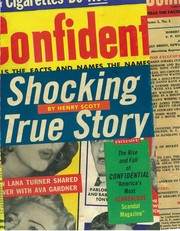Check nearby libraries
Buy this book

Tom Wolfe called Confidential “the most scandalous scandal magazine in the history of the world”. . . Humphrey Bogart said “everybody reads it but they say the cook brought it into the house”. . . To Time the magazine was “a cheesecake of innuendo, detraction and plain smut.”
Here is the never-before-told tale of America’s first scandal magazine, which forever changed the nation’s image of Hollywood and can be credited (or blamed) for being the progenitor of the likes of the National Enquirer, the Star, E!, Access Hollywood and TMZ.com.
Confidential, first published in 1952, came out every two months. Its pages were filled with racy stories about sex and political scandal, leavened with consumer advice about the dangers of cigarettes and various medical remedies that was ahead of its time. It was lavishly illustrated, printed on pulp paper, and cost only a quarter. At the height of its popularity its circulation of five million made it America’s best selling newsstand publication.
Readers loved its lurid red and yellow covers with cover lines that shouted about the sensational stories inside. These were stories that couldn’t be found in movie magazines such as Photoplay and Modern Screen or Hollywood trade publications such as Variety and the Hollywood Reporter -- all financially dependent on—or controlled by—the Hollywood studios.
In Confidential’s pages, Americans saw movie stars and heroes exposed as wife beaters (Bing Cosby), homosexuals (Rock Hudson and Liberace), neglectful mothers (Rita Hayworth), criminals (Rory Calhoun), sexual obsessives (June Allyson) and mistresses of the rich and dangerous (Kim Novak, one of whose lovers was a mysterious arms merchant).
Confidential’s alliterative headlines told of tawny temptresses (black women passing for white); pinko partisans (Communist sympathizers); lisping lads (homosexuals). . . and promised its readers what the newspapers and fan magazines wouldn’t reveal: “The Real Reason for Marilyn Monroe’s Divorce: From a Detective’s Report”. . . How “James Dean knew he had a date with death”…
Henry Scott tells the story of the rise and fall of this magazine, which despite its eventual demise left behind a legacy of cynicism that survived the best efforts of Hollywood and Washington to suppress it. We see the two men at the magazine’s center: its founder and owner, Robert Harrison, a Lithuanian Jew from New York’s Lower East Side who wrote for New York Graphic and published a string of “girlie” magazines, including “Titter,” “Wink” and “Flirt” (Bogart called Harrison the King of Leer). . . and Confidential’s most important editor—Howard Rushmore, a small town boy from a Wyoming homestead who was a passionate ideologue. Rushmore, a former member of the Communist party who wrote for the Daily Worker, renounced his party affiliation and became a virulent Red-hunter, close pal of FBI director J. Edgar Hoover and expert witness before the House Un-American Activities Committee, naming the names of actors and writers Rushmore claimed had been “fellow travelers.”
The author tells how these men, with their radically different backgrounds and intensely conflicting obsessions, collaborated to create and then fought and destroyed a magazine that perfectly reflected its readers’ struggle to reconcile Hollywood’s blissful fantasy of American life with the daunting nightmare of the Cold War world. . .
Check nearby libraries
Buy this book

Subjects
Hollywood, Broadway, Scandal, Celebrity, Desi Arnaz, Lucille Ball, Rock Hudson, Lizabeth Scott, Marilyn Monroe, Robert Harrison, Rita Hayworth, Clark Gable, Tab HunterPeople
Desi Arnaz, Lucille Ball, Rock Hudson, Lizabeth Scott, Marilyn Monroe, Robert Harrison, Rita Hayworth, Clark GablePlaces
Hollywood, New York CityTimes
1950s, Hollywood, Broadway, New York CityShowing 1 featured edition. View all 1 editions?
| Edition | Availability |
|---|---|
|
1
Shocking true story: the rise and fall of Confidential, "America's most scandalous scandal magazine"
2010, Pantheon Books
in English
0375421394 9780375421396
|
aaaa
Libraries near you:
WorldCat
|
Book Details
Edition Notes
Includes bibliographical references and index.
Classifications
The Physical Object
ID Numbers
Links outside Open Library
Community Reviews (0)
Feedback?| March 11, 2012 | Edited by Henry E. Scott | Edited without comment. |
| March 11, 2012 | Edited by Henry E. Scott | Added details |
| January 30, 2010 | Edited by WorkBot | add more information to works |
| December 11, 2009 | Created by WorkBot | add works page |











